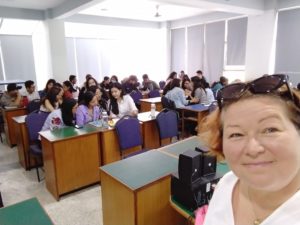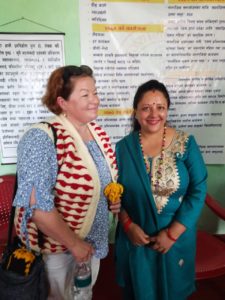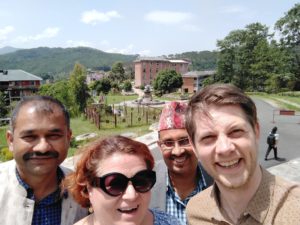Humak Visited Nepal With the Aim of Project and Educational Cooperation as Well as Student Mobility

During the last few years, Humak has explored cooperation opportunities in Nepal, especially in the field of higher education. At the end of May, Humak’s lecturers Tero Lämsä and Kristiina Vesama finally got the opportunity to go to Nepal to discuss project ideas, educational cooperation and student mobility. The main destination was Kathmandu University where Lämsä and Vesama also got to conduct workshops for students. In addition, the duo visited local organizations with the intention of cooperation.
Humak is constantly striving to expand its international networks, and Nepal has been in the sights for several years. Covid has slowed down the process, but at the end of the spring, the diverse cooperation plans could finally be taken to another level face-to-face. Prior to this, in March, Humak had received Nepali guests through the Erasmus+ Global mobility program, which also enabled this trip in the other direction in May.

Rewarding Moments in Nepal: Teaching and Organization Visits
Kathmandu University had visitors from Humak at the end of May when lecturers Tero Lämsä and Kristiina Vesama finally got to travel to Nepal. The goal of the trip was to prepare project ideas and educational cooperation as well as to discuss student mobility.
“At Humak, we are constantly trying to build broader shoulders for international work,” says Vesama.
The trip largely consisted of various meetings and discussions related to the cooperation plans. The lecturers also got to teach at Kathmandu University. Vesama led a workshop on project expertise and social entrepreneurship, while Lämsä spoke about the basics of adventure education, engaged pedagogy and Finnish youth work.
Lämsä and Vesama also visited two organizations: Youth Advocacy Nepal and Bright Light. The intention behind the touching visits was to get to know what organizational work is like in Nepal and to discuss the possibility that Humak students could visit or even do part of their internship in these organizations if the plans regarding student mobility come to fruition.
Humak Is Building a Better Future Globally Through Development Cooperation
One of Humak’s goals is also to start a project in cooperation with Kathmandu University. This is why the possibilities of the HEI ICI (Higher Education Institutions Institutional Cooperation Instrument) funding program were explored. It finances the development cooperation of Finnish higher education institutions outside of Europe. The funding supports the development of higher education institutions in developing countries, such as Nepal. The target of development could be, for example, administrative capabilities, pedagogical skills, curriculum development or online learning.
“International cooperation is important to Humak, because it brings us more know-how and at the same time we can share our own know-how as part of teaching, for example,” states Vesama. “Humak’s mission is to build a better future globally.”
At the moment, however, Humak has very few good cooperation relationships in Asia. Now one is in the making, and the goal is to get student mobility and internships there as well.
Earlier this year, we also reported that next fall, Humak will offer training for mountain and river guiding in Nepal in cooperation with Summit Leadership Academy.

At Kathmandu University, People Are Motivated To Learn From Elsewhere
The higher education field in Nepal is very different compared to Finnish practices. After all, Kathmandu University is a private institution.
“You have to remember that in Nepal, higher education is a huge privilege because it’s not free,” reminds Vesama. “Of course, this also indirectly affects the motivation to study.”
Students generally come from relatively wealthy families, so it is good to remember that there are certainly many young people in Nepal who have no chance of getting into higher education without scholarships. On the other hand, those who do get into higher education are really interested and motivated to study as well as to learn and use the English language.
“At Kathmandu University, people were really interested in what is taught in other parts of the world,” says Vesama. “Many teachers had gone to study in Europe, the United States or Canada. It’s the kind of thing that we here in Finland could also learn and boldly seek thoughts and ideas from somewhere else.”
Old-fashioned Practices and Challenges at Kathmandu University
There were also some old-fashioned practices at Kathmandu University in terms of, for example, teacher authority. For instance, when the teacher enters the class, the students stand up. However, the students were surprisingly active and did a lot of group work et cetera.
However, it must be noted that, during such a short visit, the visitors only have time to see the surface of what everyday life and teaching at the university really look like. Challenges such as equality and accessibility are easily left in the background.
“In our discussions, however, it became clear that they also have, for example, blind and deaf students, but unfortunately they do not have enough skills or tools to promote that aspect,” says Vesama.

The Next Concrete Steps To Promote Cooperation Will Be Taken in the Coming Autumn
Overall, the visit was successful and a wonderful experience.
“Nepal is an incredibly beautiful and fascinating country,” states Vesama. “It’s also great that there is a really huge desire to develop civil society and democracy.”
There were some bumps in the road as well – a stomach bug came along as a souvenir and the trip home ended up taking 40 hours. More importantly, however, there is now a good foundation for future cooperation plans. These will hopefully progress already during the fall. A new round of applications for the HEI ICI funding will open in the fall, and we shall take advantage of it. If everything goes as expected, the plan is to try a reciprocal pilot education module where Humak offers Kathmandu University one of its courses in English and vice versa.
“The plan is to try online learning going both ways with a small number of students in order to get concrete experiences of how Nepali students experience our teaching and vice versa,” says Vesama.
Close cooperation is important so that the next steps can be taken to implement this. For now, the planning continues remotely, but according to Vesama, trust and community spirit must also be built face-to-face.
“It’s clear that good cooperation cannot be built online only,” Vesama says. “Hopefully, in the future, it would also be easier to get students to come along.”
Text: Mari Ervasti
2022-07-21 15:45:39